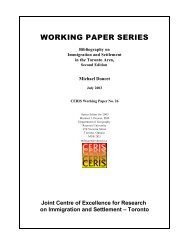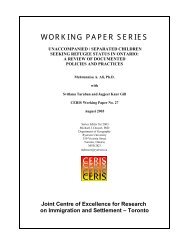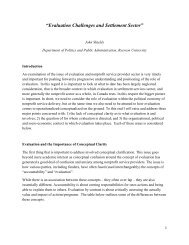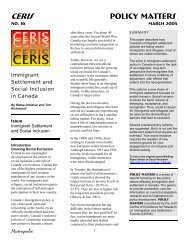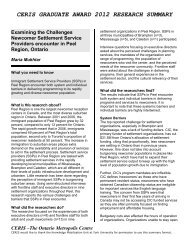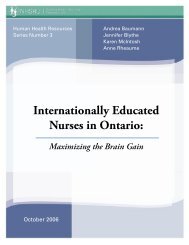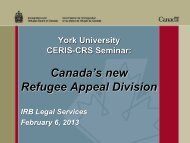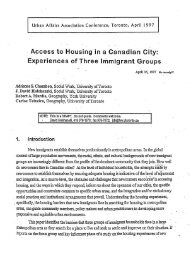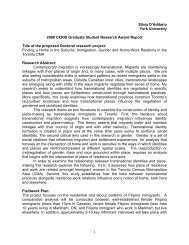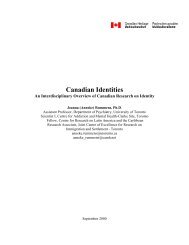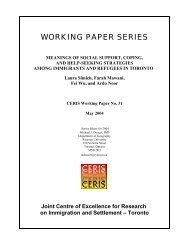Ethno-Racial Inequality in the City of Toronto: An Analysis of the ...
Ethno-Racial Inequality in the City of Toronto: An Analysis of the ...
Ethno-Racial Inequality in the City of Toronto: An Analysis of the ...
Create successful ePaper yourself
Turn your PDF publications into a flip-book with our unique Google optimized e-Paper software.
Fully 96.1 percent <strong>of</strong> <strong>Toronto</strong>nians who identify <strong>the</strong>mselves as only Aborig<strong>in</strong>al speak only English<strong>in</strong> <strong>the</strong>ir homes and ano<strong>the</strong>r 2.3 percent speak some English at home. For <strong>the</strong> considerably larger number<strong>of</strong> people who describe <strong>the</strong>mselves as hav<strong>in</strong>g both Aborig<strong>in</strong>al and ano<strong>the</strong>r, European orig<strong>in</strong> English iseven more prevalent.Among <strong>the</strong> African, Black and Caribbean groups, less than 25 percent <strong>of</strong> Ethiopians and Ghanaiansspeak only English at home, compared to 47.5 percent <strong>of</strong> Somalis and 62.8 percent <strong>of</strong> people from “o<strong>the</strong>rAfrican nations”; <strong>the</strong> percentage rises to over 80 percent for <strong>in</strong>dividuals with an African and non-Africanorig<strong>in</strong>. Nearly 95 percent <strong>of</strong> <strong>Toronto</strong>nians who say that <strong>the</strong>y are African or Black speak only English athome.Among East and Sou<strong>the</strong>ast Asians, 65.5 percent do not speak English or French at home, though<strong>the</strong>re is also considerable variation: 75.7 percent <strong>of</strong> <strong>the</strong> Ch<strong>in</strong>ese, 82.8 percent <strong>of</strong> <strong>the</strong> Vietnamese and 68.7percent <strong>of</strong> <strong>the</strong> Koreans do not speak English or French at home, compared to 26.2 percent <strong>of</strong> <strong>the</strong> Japaneseand 41.7 percent <strong>of</strong> Filip<strong>in</strong>os. Members <strong>of</strong> <strong>the</strong> British groups speak English virtually entirely; and justover 75 percent <strong>of</strong> <strong>the</strong> French also speak only English; just 19.6 percent <strong>of</strong> people whose orig<strong>in</strong> is French(only) speak only French at home. Among <strong>the</strong> non-British, non-French Nor<strong>the</strong>rn Europeans and Jews,about 85 percent speak only English at home. For groups from <strong>the</strong> Baltic region, Eastern Europe andSou<strong>the</strong>rn Europe, an average <strong>of</strong> about 50 percent <strong>of</strong> speak only English, though <strong>the</strong>re is considerablevariation among <strong>the</strong> <strong>in</strong>dividual ethno-racial groups.––––––––––––––––––––––––––––––––––––––––––––––––––––––––––With such large differences <strong>in</strong> <strong>the</strong> age distributions <strong>of</strong> ethno-racial groups we must question <strong>the</strong>demographic generalities that seem to drive debates about social policy. Some ethno-racial groups donow face <strong>the</strong> dilemmas <strong>of</strong> an ag<strong>in</strong>g population; but o<strong>the</strong>rs have had many years to adjust to decl<strong>in</strong><strong>in</strong>gfertility and <strong>in</strong>creased numbers <strong>of</strong> elderly. More strik<strong>in</strong>g, however, for many ethno-racial groupsconcerns about <strong>the</strong> effects <strong>of</strong> ag<strong>in</strong>g are many years <strong>of</strong>f. Instead <strong>the</strong>y have high proportions <strong>of</strong> relativelyyoung adults and children and must be primarily concerned with car<strong>in</strong>g for <strong>the</strong>ir children. They are facedwith a broad economic context <strong>in</strong> which <strong>the</strong>re has been a steady decl<strong>in</strong>e <strong>in</strong> poverty among <strong>the</strong> elderlyrelative to poverty among young people and children. In comparison, <strong>the</strong> large number <strong>of</strong> immigrants <strong>in</strong>our <strong>City</strong> and historical shifts <strong>in</strong> <strong>the</strong>ir orig<strong>in</strong>s are well known. What we can add, aga<strong>in</strong>, is that <strong>the</strong><strong>Ethno</strong>-<strong>Racial</strong> <strong>Inequality</strong> <strong>in</strong> <strong>Toronto</strong>: <strong>An</strong>alysis <strong>of</strong> <strong>the</strong> 1996 Census 33



